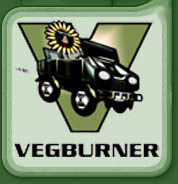Theory
of Vegetable Oil Use as a Fuel
1 The Diesel Engine
2 Theory of Vegetable Oil Use as a
Fuel
3 Engine suitability
4 Heating the Oil
5 Biodiesel
6 Micro Emulsions and Blends
7 Vegetable Oil Engine Design
8 Vegetable Oil Furnaces and Heaters
9 Oil Types and Filtering
10 Taxation
11 Implications of Vegetable Oil
Fuel Use
12 Sources
Put in the simplest terms, the only reason a diesel engine
can not run on straight vegetable oil (SVO) is if at ambient
temperature the oil is too thick to run through the fuel lines
and filters of the engine at the required rate. The design
of the engine, especially the fuel system and combustion chamber,
and the type of vegetable oil used will dictate at what ambient
temperature the engine will start.
Even if the fuel system can pump the thicker oil there is
risk of damage to the engine. SVO will not be injected into
the cylinders as effectively as diesel fuel, the injector
will not provide as fine a fuel mist with this less viscous
oil. A mist of larger droplets will not burn as effectively
causing difficulty with starting and incomplete combustion
which will lead to build ups of carbon and vegetable oil residue.
As deposits build in the engine they will cause the engine
to run poorly because of low compression due to sticking piston
rings or coked valves and poor injection spray pattern from
build ups on the injector nozzle. A bad spray pattern will
produce different combustion activities with a greater amount
of incomplete combustion and possible piston damage due to
increased heat on the piston surfaces, this can end in a holed
piston .
Engine carbon build ups can be a problem with diesel fuelled
engines which have not been run hard/hot enough. It is advisable
to work diesel engines hard fairly regularly to burn this
carbon from the engine, more so when running on vegetable
oil. A standing start to high speed pedal to the metal run
or a very long uphill haul has been shown to help. Extended
periods at low engine load or tick over are best avoided when
possible. Combustion is less complete from when the engine
is first started until it reaches operating temperature as
the piston rings do not seal as efficiently until the various
engine components have expanded with the combustion heat.
It is good practice to drive fairly hard upon first starting
the vehicle to bring it up to operating temperature as soon
as possible.
The greater effort required to pull the vegetable oil through
fuel lines and filters can damage the fuel injector pump or
the extra force required to move this oil through the pump
causes extra stress on the timing belt/chain which could give
out prematurely, causing costly engine damage.
Some engines have been found to be able to operate reliably
under given conditions without modification when fuelled with
certain oils.[10][28][29][30]
Engine Modification
Engines have been designed to overcome potential problems
and run on vegetable oil. Heating the fuel system allows the
SVO to flow and an improved injector and combustion chamber
design give better combustion.
A German company called Elsbett [32]
has worked extensively on vegetable oil fuelled engines since
the 1970’s and at one stage offered SVO engines, unfortunately
low demand due to the high cost of these hand built engines
compared to mass produced diesel engines forced their engine
out of production. They now offer a service converting existing
diesel engines to run on SVO.
Fuel Modification
Another solution is to thin the vegetable oil so that it
behaves in a similar way to diesel fuel and can be used in
existing diesel engines. There are a number of options
Biodiesel
Biodiesel is a fuel made through transesterification. About
80% vegetable oil is mixed with 20% alcohol and a catalyst.
A chemical reaction occurs (transesterification) and you are
left with biodiesel and glycerin which separate out when allowed
to settle.
Biodiesel in operation is comparable to fossil diesel in most
ways.
Micro Emulsions and Fuel Blends
Vegetable oil can be mixed with alcohols, diesel fuel, petrol,
surfactants, cetane improvers, water and solvents in varying
mixes and proportions to form a micro emulsion or a blend
with suitable operating qualities
Heating the Oil
Above 70 degrees Celsius vegetable oils have a viscosity
approaching that of diesel fuel. The design of an engines
fuel system and combustion chamber will dictate at what temperature
vegetable oil can be reliably run as a fuel.
1 The Diesel Engine
2 Theory of Vegetable Oil Use as a
Fuel
3 Engine suitability
4 Heating the Oil
5 Biodiesel
6 Micro Emulsions and Blends
7 Vegetable Oil Engine Design
8 Vegetable Oil Furnaces and Heaters
9 Oil Types and Filtering
10 Taxation
11 Implications of Vegetable Oil
Fuel Use
12 Sources
|



